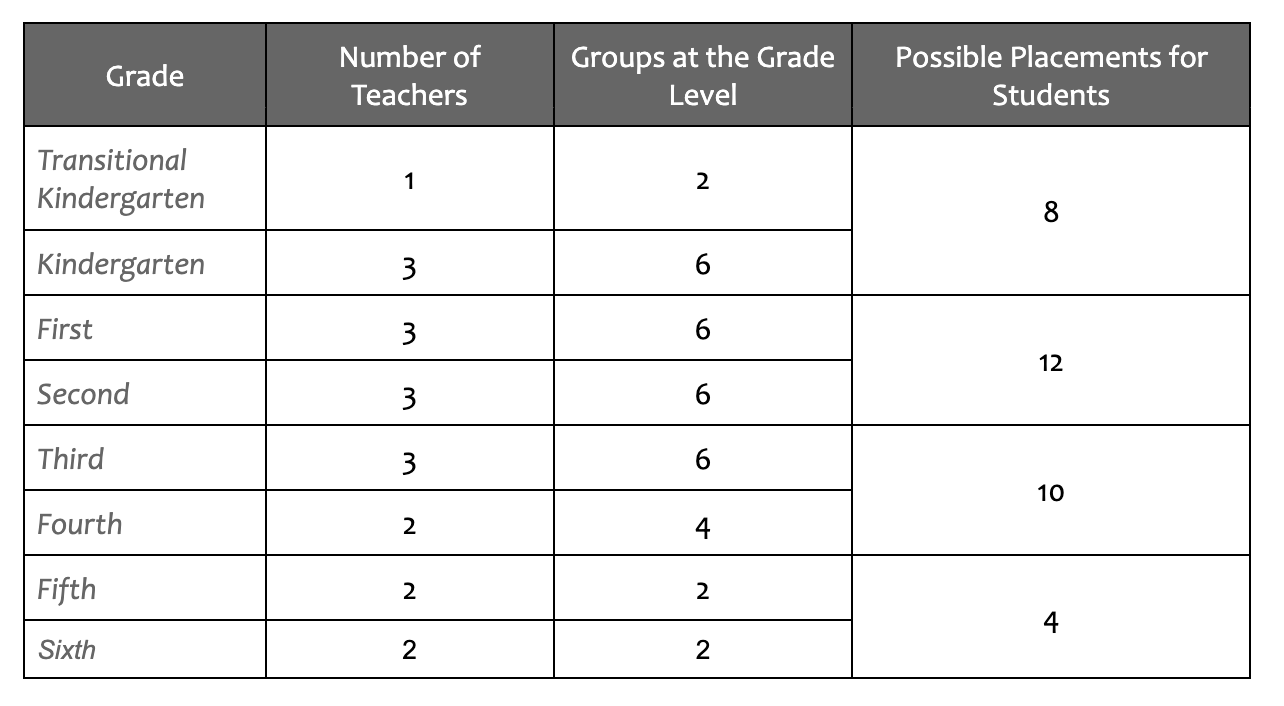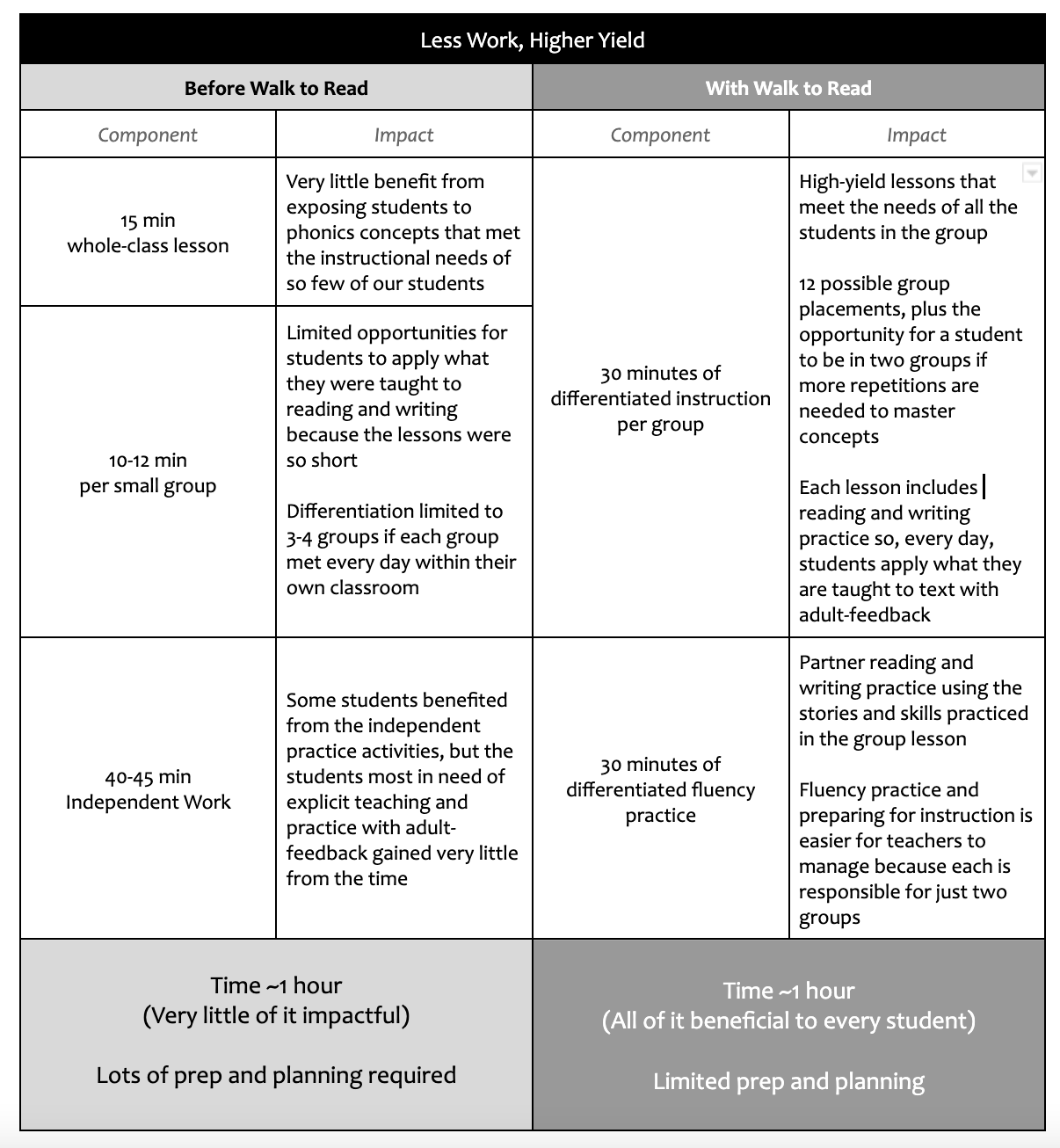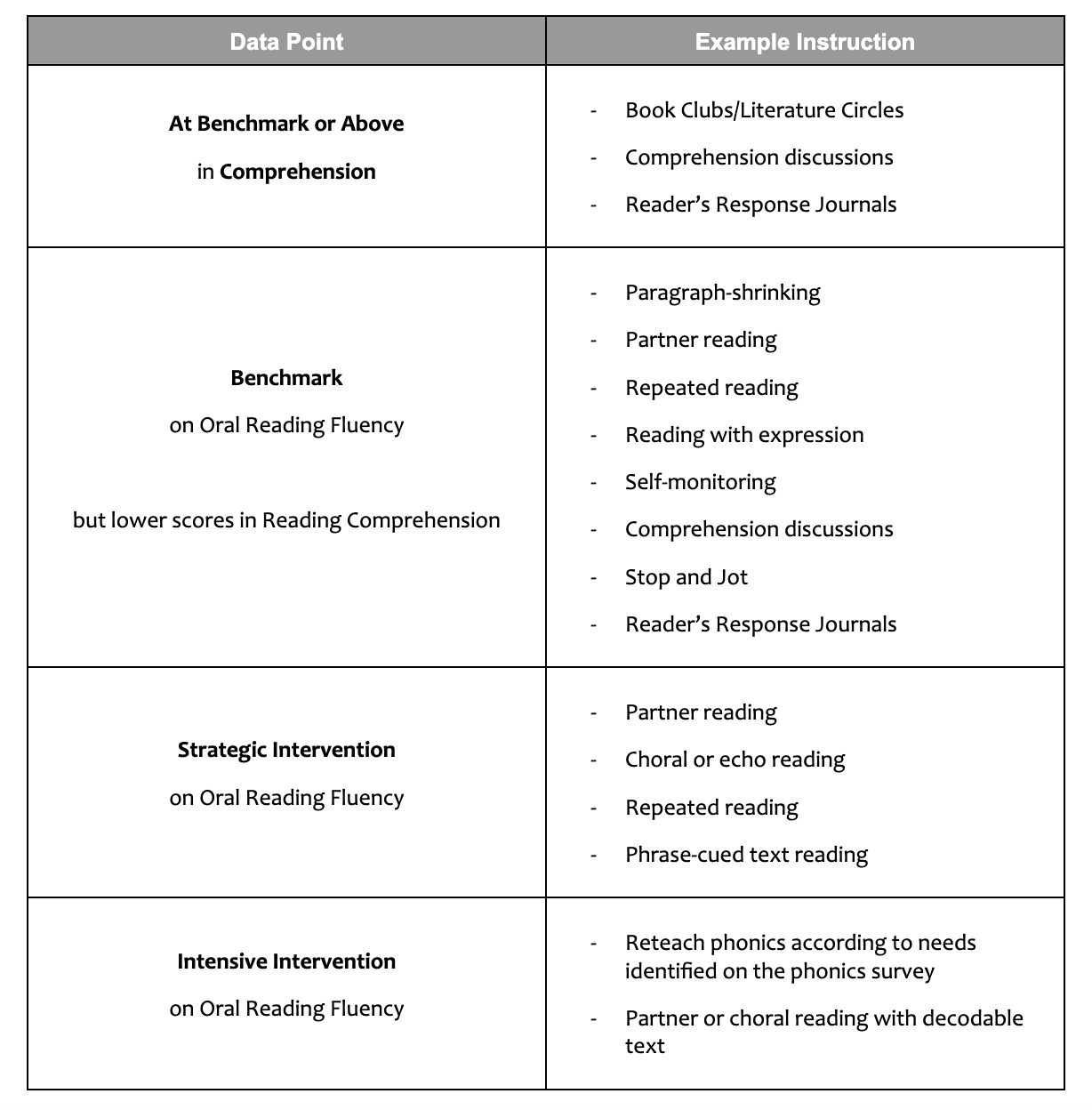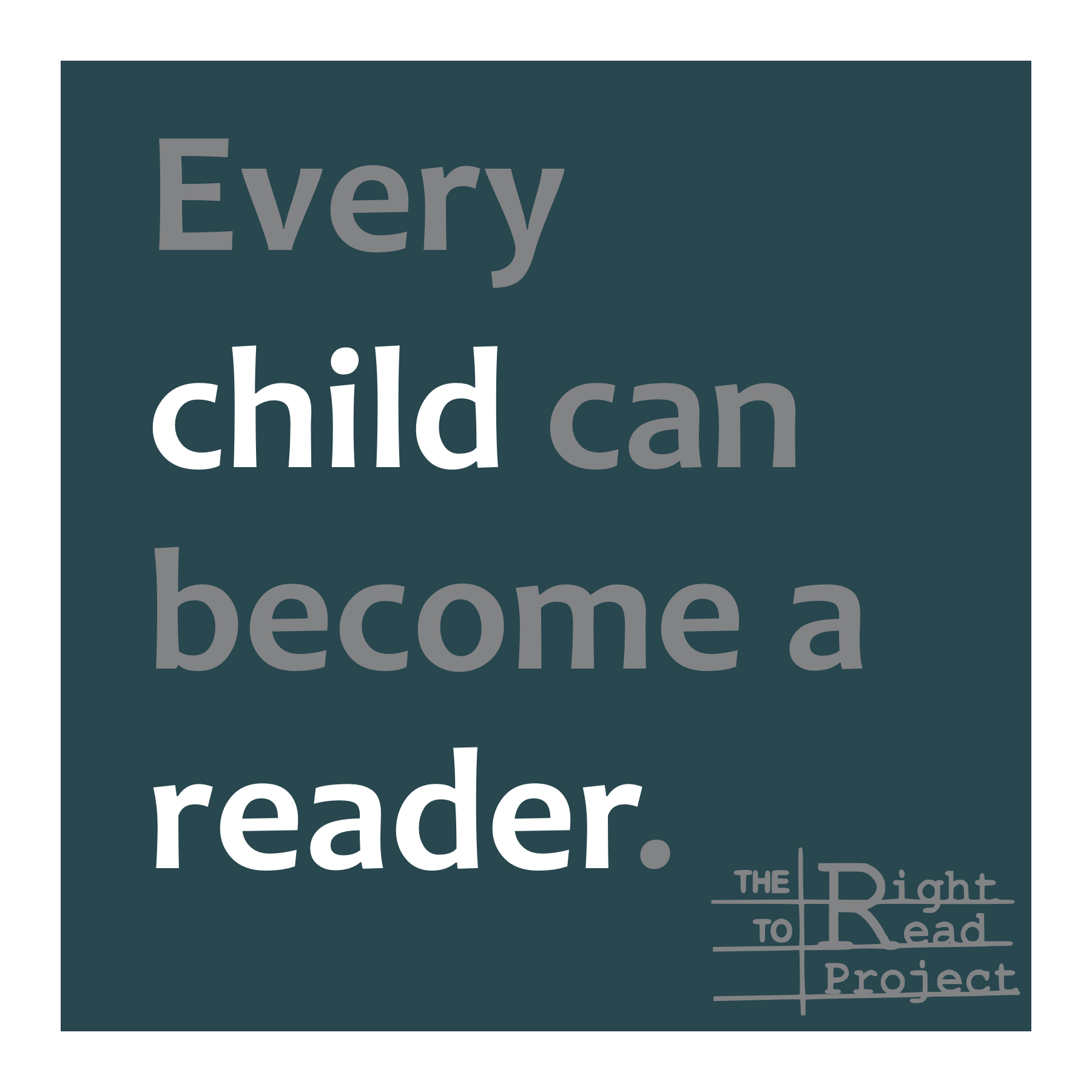When we’re asked to switch to explicit, systematic instruction, many teachers worry that we’ll no longer be able to tailor our teaching to the students in front of us.
Calls for whole-class phonics instruction lasting 30-45 minutes, for example, summon fears that our students will be bored by concepts they already know or aren’t yet ready for. And they resurface memories of teachers stripped of our ability to differentiate instruction as we recall problematic implementation plans during No Child Left Behind.
Part of the enduring appeal of Balanced Literacy is that it acknowledges the varied needs of our students. But differentiation in Balanced Literacy classrooms includes strategies that aren’t evidence-based, such as assessments like the F&P BAS to determine leveled reading groups, coaching students on word-guessing strategies, and opportunistic phonics instruction.
And because Guided Reading groups tend to be small, the rest of the class spends a long time waiting for instruction. Frameworks have been developed (e.g., Daily 5, Reading Workshop, literacy centers) to make the waiting time feel productive, but there’s still a real opportunity cost for each small group lesson and individual conference.
Still, many schools hold tight to their identities as Literacy Collaborative or TCRWP schools because they don’t want to lose their focus on literacy and the benefits of a staff united around a vision for instruction.
But there are other, better ways to differentiate instruction in foundational skills (phonics and fluency practice) or language instruction (ELD/ESL/ESOL).
To differentiate instruction effectively, schools need a model that is:
- Based on reliable data
- Focused on evidence-based instruction
- Coordinated across a grade level or school
- Effective at meeting the needs of diverse learners
What does it take?
How we’re able to differentiate reading instruction depends on the size of the school, its resources, and students’ reading data, but I’ll share my school’s structure as an example.
If we can make gains, any school can.
For context, Nystrom Elementary has historically been a failing school, but after implementing a new model for literacy in 2021, we rebounded from over a year spent in distance learning, our school had higher proficiency than ever recorded before, and our student growth is now among the fastest in our district.
We have about 450 students enrolled in Transitional Kindergarten to sixth grade:
- 75% Latinx
- 20% Black/African American
- 66% English Learners
- 95% Free and reduced lunch
We do not have teachers’ aides, tutors, an interventionist, or parent volunteers to leverage, so the work of differentiation is held by our classroom teachers with the support of a literacy coach (me) and our principal.
So what does it actually look like?
During Each School Day
We are a structured literacy island in a sea of Balanced Literacy. At my school, all students read, talk, and write about grade-level text for an hour or more during a block of time centered around a knowledge-building curriculum.
Our staff’s professional development focus this year is on Integrated ELD, and we are learning how to scaffold discussions and writing tasks so all students get the most out of these rich texts.
But many of our students don’t have the phonics knowledge and reading fluency necessary to read grade level texts without support, so my whole school has also banded together for differentiated instruction in foundational skills.
We have “Walk to Read,” a dedicated block of time during which students receive foundational skills instruction aligned with their needs. This is the second year of our implementation and it’s evolved quite a bit as teachers have used their experience to refine the model.
Launching Walk to Read
Last school year, our staff learned how decoding difficulties (like slow letter recognition and unfamiliar spelling patterns, etc.) impact reading rate and comprehension. Then, we dug into a phonics curriculum that provides a sequence for foundational skills instruction spanning kindergarten to fourth grade and intervention for fifth and sixth grades.
The program includes a diagnostic assessment to determine where in the lesson sequence each student should be placed for instruction. Similar to the BPST or CORE Phonics Survey, the phonics assessment takes only a few minutes and it allows us to see any gaps in our students’ phonics-knowledge.
Making groups from this data could be daunting for any individual teacher because of the range of abilities in each classroom. But grade level teams worked together to sort the data and each teacher stepped up to teach two groups:

Last year, nearly all the teams decided on the same time for Walk to Read. While this made the schedule simple, it reduced the opportunities my principal and I had to observe and model lessons. (And it made our subbing for absent teachers a logistical nightmare in a year of many COVID-related absences.)
So this year, each grade-band has a different block of time during the day, and they’ve even adjusted the amount of time they devote to Walk to Read based on the amount of direct instruction and accurate reading practice their students need according to their stage of reading development.
During Walk to Read
Each block of Walk to Read includes time to teach two groups. While in their group’s lesson, students are taught a spelling-sound pattern they are ready to apply to their reading and writing. The block also provides the amount of fluency practice necessary for students to apply their skills to reading and writing. Independent work activities vary from class to class according to students’ ability, but they tend to include some additional phonics practice, partner reading, and time for students to write about what they’ve read.

The amount of repetition students require to master a phonics skill varies widely. For some students, introduction to a spelling pattern followed by reading and writing with it during one lesson is enough for them to master the skill. But other students require an enormous amount of repetition in order to secure connections between letters and the sounds they represent.
Our groups are able to move at different paces through the content, giving students sufficient (but not unnecessary) reteaching.
For students who have mastered the phonics of their grade level, we use reading fluency and comprehension data to determine their instruction.

Monitoring Progress
For students in fluency interventions or book clubs, we monitor progress with Oral Reading Fluency (e.g., DIBELS ORF) and/or comprehension assessments (e.g., MAZE and STAR).
For students receiving phonics instruction, we use the curriculum-embedded tool for progress-monitoring. Every 1-2 weeks, each student receives a quick test for mastery of the content they were recently taught.
We enter the data into a shared spreadsheet and use it to determine the need for reteaching or regrouping, and to reflect on the efficacy of our instruction. Last year, our spreadsheet color-coded the individual student scores on our curriculum’s embedded criterion-referenced progress-monitoring assessment (80% on each section is the expectation for mastery).
As the year progressed, we realized that knowing each group’s pass-rate was essential to guiding instruction and coaching, so teachers worked over the summer to create an even better tracker for this year.
Now we can easily see the pass-rate for each group and also monitor the amount of reteaching and retests that it takes for each of our students to master skills.
Using the Data
We review the data in team meetings, roughly every two weeks. These meetings are facilitated by grade-level teacher leaders, who guide the teams through the process of data analysis and ensure our school-wide norms for looking at data are upheld:
Each teacher shares the pass-rates for their group’s most recent mastery test, knowing that a high pass-rate (~75%+) is the criterion for effective Tier 1 foundational skills instruction. We discuss students’ growth and difficulties and help each other to refine instruction so that it meets the needs of our students.
Prerequisite: Humility
When discussing the Walk to Read model in a staff meeting, we all laughed after reading this quote:
“In its best form, walking to read allows for more targeted, more efficient, more streamlined planning, instruction and assessment monitoring. It’s a GREAT option for a highly functional staff.”
Differentiating Reading Instruction and the Walk to Read Model – Hit or Miss?
We are “a highly functional staff” as a result of years of consistent and strong leadership, a culture of instructional coaching, and ongoing work focused on student data.
We’re also a humble staff that is committed to improving instruction so we can accelerate student learning. Prior to beginning this work last year, my principal began a staff meeting by saying,
“I don’t want us to complain about ‘learning loss’ this year. Our students can’t have lost anything they weren’t given. Instead, I’d rather that we focus on the unfinished teaching and how we’re going to deliver it.”
Each teacher voluntarily committed to using an evidence-based, scripted program for teaching foundational skills. We want students to experience continuity across grade levels, and we see how aligning our instruction, which in turn deepens adult collaboration, benefits our students.
I asked one teacher how she felt about teaching a scripted program for about an hour each day and she said:
“I feel relieved. We’re seeing more growth than we ever have before and I know it’s because we’ve finally found something that works. I want to stick with it. I’d rather us all do something that works than see kids fail because we’re experimenting and making stuff up.”
It’s been said that “because teachers are paid so little, we compensate ourselves with autonomy,” but developing our own differentiated instructional plans becomes wearisome if that work doesn’t lead to improved student outcomes.
The Walk to Read model is energizing not only because of the teamwork necessary to coordinate instruction, but because we see exactly how each teacher contributes to the greater good of our school. We see how each teacher pitches in to meet the needs of our school’s 450 individual readers.









I am trying to wrap my head around this concept. I can see the benefit. We used to do walk to read, but changed with new administration and curriculum director. Do you do whole group reading first or just walk to read. I am seeing about 60 to 70 minutes for this work, but we have 90 minutes. We have always advocated that all students should be in the class for whole group reading instruction to hear and discuss the story. This allows for new, robost vocabulary and concepts being introduced.
We have an hour for grade-level comprehension work in addition to the differentiated foundational skills instruction for all grade levels. In upper grades, where the need for phonics intervention is less, we do 1 hour grade-level instruction in reading and then ~45 minutes for fluency/phonics/book clubs etc. In the lower grades, the Walk to Read period is a full hour.
Interesting. Do some students from the same class have a different teacher depending on the group they are ‘reading at’?
When I was teaching Grade 2 twenty years ago, I found Readers’ Theatre was a great way for students to practice repeat reading and develop fluency. Students would do this while I was working directly with other groups.
I didn’t have decodable books or a literacy system/program to use. Those would have helped and saved a lot of my time.
Yes, students may have their classroom teacher for foundational skills instruction or they may be in the group of any other teacher at the grade level band.